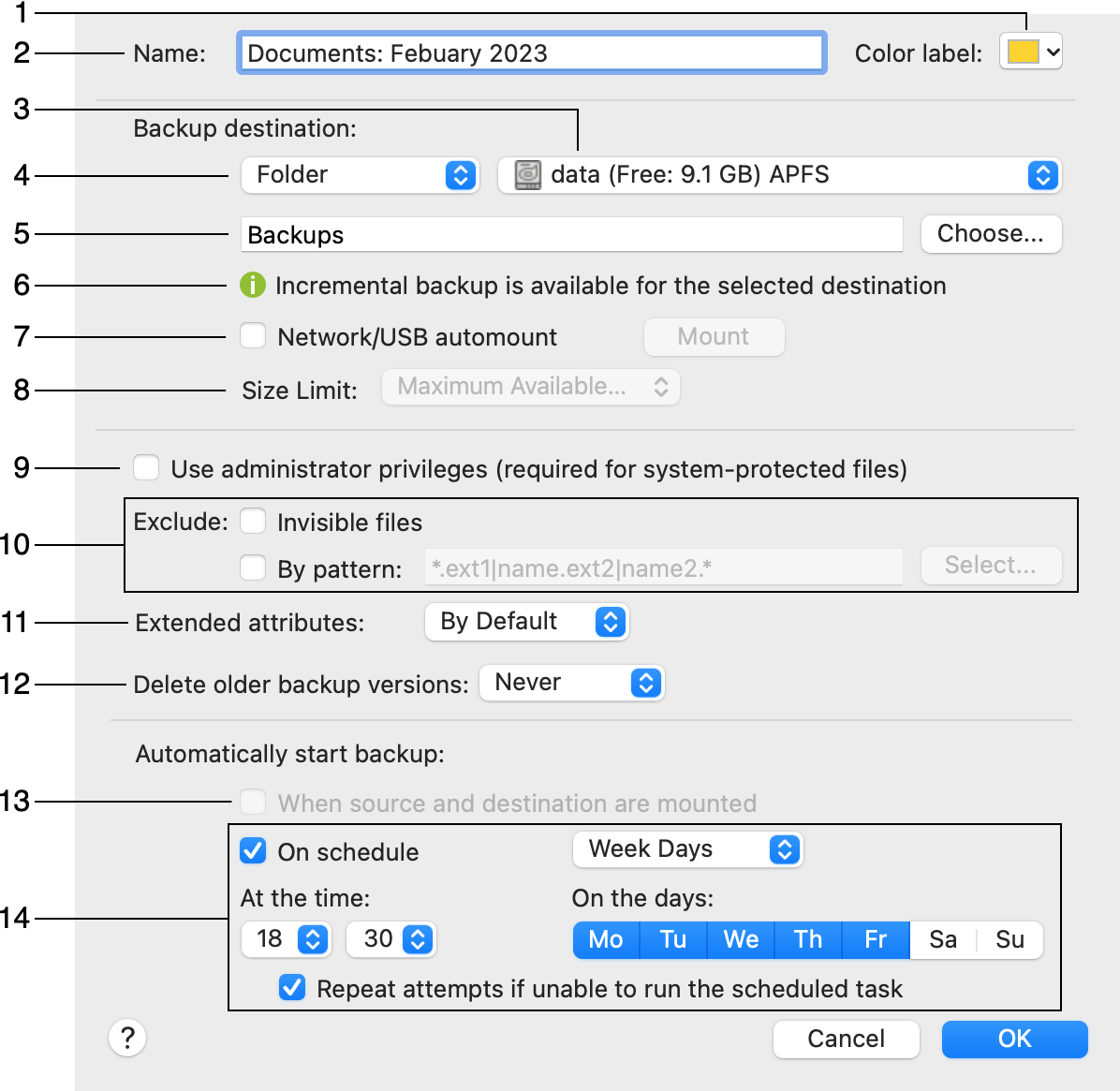Creating Backups
To open the Properties dialog, click the gear icon below the project list or choose Process > Properties/Schedule… menu item.

1 - The color of the tag in the project list. This can help you highlight projects by importance, frequency of creation or by other principle.
2 - The project name. It is displayed in the main window. Note that projects with identical names are not allowed.
3 - The backup destination drive. Here you can choose a volume, removable drive, network drive or another storage available on your computer. If you select a network drive, the program will display two more controls. The Network/USB automount check box allows the program to mount the selected disk automatically before writing files to it. The Mount button lets you mount the selected disk manually. (*)
4 - A way to store backed up files. The default Folder option lets you store files in the destination folder directly. If the Disk Image option is selected, a disk image will be created in the destination folder. This disk image will contain your files. You can also choose an encrypted disk image. (*)
5 - Select a folder on the destination drive. (*)
6 - Information about the possibility to create a backup with the selected destination drive and folder.
7 - If the destination folder or original files are located on a network or external drive, you can choose to mount it automatically.
8 - Disk image maximum size. This option is available when a disk image is selected as a container for the backup. Disk images can increase their capacity when you add more files. You can specify the maximum space the disk image can take. By default, the maximum is set to all available space on the destination disk. You have an option to input an arbitrary maximum size, but be aware of the physical capacity of the destination volume.
9 - Run the program with administrator privileges. To activate this option, you will have to input the administrator's password.
10 - The Exclude section allows you to create a set of rules for automatic exclusion of files from the archive. By selecting the By pattern check box, you can create your own rule. This is described in the Exclude Files by the Pattern section.
11 - The option to sync or ignore the extended attributes. Files on your Mac may have extended attributes that are not supported by the destination file system. In this case, you can tell the program to ignore them to avoid error messages in the log.
12 - Activate or deactivate removing old versions of the backup automatically.
13 - Activate the automatic backup creation when the source and destination volumes are mounted.
14 - Activate the automatic backup creation by schedule.
Note that changing the options marked with the asterisk (*) make the program to create a new destination folder or disk image. Consequently, backups will be distributed between several folders, disk images or both. This can also affect the possibility to restore from some of the backups because the Restore dialog restores only from the currently selected destination.
A folder added to your project may contain some files which you don't want to back up. The Exclude tool can help you automatically exclude such files.
You can choose a predefined file type or create your own pattern. To do this, activate the By pattern option and select a file you want to exclude. For example, if you select a report.txt file and choose the "the same extension" option, all .txt files will be excluded.
A pattern can contain a file name or extension, or both. Several patterns can be combined to create a complex rule.
To add a pattern:
You can create a pattern manually by typing it into the edit box. You should follow these rules:
The more times you run the same backup project, the more versions of this backup can be stored on your drive taking more and more space. The program can delete old versions of the backup (let's call them old backups) in order to free disk space for new ones. Old backups to be removed are removed instantly.
The program removes old backups when you close it.
An old backup will be removed only if a new version of the backup is created successfully.
There are two ways to define which of the backups should be deleted. The first method lets you define for how long to store backups by selecting the After option. If you set "After 2 Months", the program will keep backups created within the two recent months. Backups created earlier will be deleted.
The second method allows you to set up the maximum number of versions stored at the same time using the Exceeding option. If you select "Exceeding 3 versions", the program will keep the three most recent backups.